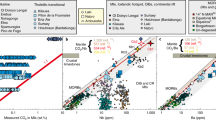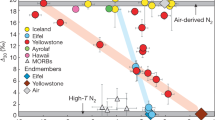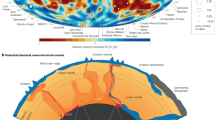Abstract
Estimates of carbon concentrations in Earth’s mantle vary over more than an order of magnitude, hindering our ability to understand mantle structure and mineralogy, partial melting, and the carbon cycle. CO2 concentrations in mantle-derived magmas supplying hotspot ocean island volcanoes yield our most direct constraints on mantle carbon, but are extensively modified by degassing during ascent. Here we show that undegassed magmatic and mantle carbon concentrations may be estimated in a Bayesian framework using diverse geologic information at an ocean island volcano. Our CO2 concentration estimates do not rely upon complex degassing models, geochemical tracer elements, assumed magma supply rates, or rare undegassed rock samples. Rather, we couple volcanic CO2 emission rates with probabilistic magma supply rates, which are obtained indirectly from magma storage and eruption rates. We estimate that the CO2 content of mantle-derived magma supplying Hawai‘i’s active volcanoes is 0.97−0.19+0.25 wt%—roughly 40% higher than previously believed—and is supplied from a mantle source region with a carbon concentration of 263−62+81 ppm. Our results suggest that mantle plumes and ocean island basalts are carbon-rich. Our data also shed light on helium isotope abundances, CO2/Nb ratios, and may imply higher CO2 emission rates from ocean island volcanoes.
This is a preview of subscription content, access via your institution
Access options
Access Nature and 54 other Nature Portfolio journals
Get Nature+, our best-value online-access subscription
$29.99 / 30 days
cancel any time
Subscribe to this journal
Receive 12 print issues and online access
$259.00 per year
only $21.58 per issue
Buy this article
- Purchase on Springer Link
- Instant access to full article PDF
Prices may be subject to local taxes which are calculated during checkout



Similar content being viewed by others
References
Wallace, P. J. Volatiles in subduction zone magmas: concentrations and fluxes based on melt inclusion and volcanic gas data. J. Volcanol. Geotherm. Res. 140, 217–240 (2005).
Hofmann, A. W., Farnetani, C. G., Spiegelman, M. & Class, C. Displaced helium and carbon in the Hawaiian plume. Earth Planet. Sci. Lett. 312, 226–236 (2011).
Saal, A. E., Hauri, E. H., Langmuir, C. H. & Perfit, M. R. Vapour undersaturation in primitive mid-ocean-ridge basalt and the volatile content of Earth’s upper mantle. Nature 419, 451–455 (2002).
Rosenthal, A., Hauri, E. H. & Hirschmann, M. M. Experimental determination of C, F, and H partitioning between mantle minerals and carbonated basalt, CO2/Ba and CO2/Nb systematics of partial melting, and the CO2 contents of basaltic source regions. Earth Planet. Sci. Lett. 412, 77–87 (2015).
Gerlach, T. M., McGee, K. A., Elias, T., Sutton, A. J. & Doukas, M. P. Carbon dioxide emission rate of Kı̄lauea Volcano: implications for primary magma and the summit reservoir. J. Geophys. Res. 107, ECV 3–1–ECV 3–15 (2002).
Poland, M. P., Miklius, A., Jeff Sutton, A. & Thornber, C. R. A mantle-driven surge in magma supply to Kı̄lauea Volcano during 2003–2007. Nat. Geosci. 5, 295–300 (2012).
Swanson, D. A. Magma supply rate at Kilauea Volcano, 1952–1971. Science 175, 169–170 (1972).
Gerlach, T. M. & Taylor, B. E. Carbon isotope constraints on degassing of carbon dioxide from Kilauea Volcano. Geochim. Cosmochim. Acta 54, 2051–2058 (1990).
Gerlach, T. M. et al. Rates of volcanic CO2 degassing from airborne determinations of SO2 emission rates and plume CO2/SO2: test study at Pu‘u ‘O‘o Cone, Kilauea Volcano, Hawaii. Geophys. Res. Lett. 25, 2675–2678 (1998).
Sutton, A., Elias, T., Kauahikaua, J. & Sutton, B. A. J. In The Pu‘u ‘Ō‘ō-Kūpaianaha Eruption of Kilauea Volcano, Hawai‘i: The First 20 Years (eds Heliker, C., Swanson, D. A. & Takahashi, T. J.) 137–148 (US Geological Survey Professional Paper 1676, 2003).
Anderson, K. R. & Poland, M. P. Bayesian estimation of magma supply, storage, and eruption rates using a multiphysical volcano model: Kı̄lauea Volcano, 2000–2012. Earth Planet. Sci. Lett. 447, 161–171 (2016).
Werner, C. & Brantley, S. CO2 emissions from the Yellowstone volcanic system. Geochem. Geophys. Geosyst. 4, 1061 (2003).
Mosegaard, K. & Tarantola, A. Monte Carlo sampling of solutions to inverse problems. J. Geophys. Res. 100, 12431–12447 (1995).
Swanson, D. A. et al. Cycles of explosive and effusive eruptions at Kı̄lauea Volcano, Hawaii. Geology 42, 631–634 (2014).
Sides, I. R., Edmonds, M., Maclennan, J., Swanson, D. A. & Houghton, B. F. Eruption style at Kı̄lauea Volcano in Hawai‘i linked to primary melt composition. Nat. Geosci. 7, 464–469 (2014).
Gerlach, T. M., Graebert, E. J., Graeber, E. J., Geralch, T. M. & Graeber, E. J. Volatile budget of Kilauea volcano. Nature 313, 273–277 (1985).
Poland, M. P., Miklius, A. & Montgomery-Brown, E. K. In Magma Supply, Storage, and Transport at Shield-Stage Hawaiian Volcanoes (eds Poland, M. P., Takahashi, T. J. & Landowski, C.) Ch. 5, 179–234 (US Geological Survey Professional Paper 1801, 2014).
Torgersen, T. Terrestrial helium degassing fluxes and the atmospheric helium budget: implications with respect to the degassing processes of continental crust. Chem. Geol. 79, 1–14 (1989).
Roberge, J., White, R. V. & Wallace, P. J. Volatiles in submarine basaltic glasses from the Ontong Java Plateau (ODP Leg 192): implications for magmatic processes and source region compositions. Geol. Soc. Lond. Spec. Publ. 229, 239–257 (2004).
Misumi, K., Yamanaka, Y. & Tajika, E. Numerical simulation of atmospheric and oceanic biogeochemical cycles to an episodic CO2 release event: implications for the cause of mid-Cretaceous Ocean Anoxic Event-1a. Earth Planet. Sci. Lett. 286, 316–323 (2009).
Evans, W. C. et al. Magmatic intrusion west of Three Sisters, central Oregon, USA: the perspective from spring geochemistry. Geology 32, 69–72 (2004).
Craddock, R. A. & Greeley, R. Minimum estimates of the amount and timing of gases released into the martian atmosphere from volcanic eruptions. Icarus 204, 512–526 (2009).
Michael, P. J. & Graham, D. W. The behavior and concentration of CO2 in the suboceanic mantle: inferences from undegassed ocean ridge and ocean island basalts. Lithos 236–237, 338–351 (2015).
Blundy, J., Cashman, K. V., Rust, A. & Witham, F. A case for CO2-rich arc magmas. Earth Planet. Sci. Lett. 290, 289–301 (2010).
Bureau, H. et al. A melt and fluid inclusion study of the gas phase at Piton de la Fournaise volcano (Réunion Island). Chem. Geol. 147, 115–130 (1998).
Aubaud, C., Pineau, F., Hékinian, R. & Javoy, M. Degassing of CO2 and H2O in submarine lavas from the Society hotspot. Earth Planet. Sci. Lett. 235, 511–527 (2005).
Marty, B. & Tolstikhin, I. N. CO2 fluxes from mid-ocean ridges, arcs and plumes. Chem. Geol. 145, 233–248 (1998).
Hayes, J. M. & Waldbauer, J. R. The carbon cycle and associated redox processes through time. Phil. Trans. R. Soc. B 361, 931–950 (2006).
Dasgupta, R. & Hirschmann, M. M. The deep carbon cycle and melting in Earth’s interior. Earth Planet. Sci. Lett. 298, 1–13 (2010).
Burton, M. R., Sawyer, G. M. & Granieri, D. Deep carbon emissions from volcanoes. Rev. Mineral. Geochem. 75, 323–354 (2013).
Helo, C., Longpré, M.-A., Shimizu, N., Clague, D. A. & Stix, J. Explosive eruptions at mid-ocean ridges driven by CO2-rich magmas. Nat. Geosci. 4, 260–263 (2011).
Pietruszka, A. J. & Garcia, M. O. A rapid fluctuation in the mantle source and melting history of Kilauea Volcano inferred from the geochemistry of its historical summit lavas (1790–1982). J. Petrol. 40, 1321–1342 (1999).
Marske, J. P., Garcia, M. O., Pietruszka, A. J., Rhodes, J. M. & Norman, M. D. Geochemical variations during Kīlauea’s Pu‘u ‘Ō‘ō eruption reveal a fine-scale mixture of mantle heterogeneities within the Hawaiian Plume. J. Petrol. 49, 1297–1318 (2008).
Blaser, A. et al. Effect of CO2 Content on Magma Supply Rate at Kilauea Volcano, Hawaiiabstr. EGU2014-9862-1 (EGU General Assembly, 2014).
Deines, P. In Early Organic Evolution: Implications for Mineral and Energy Resources (eds Schidlowsk, M., Golubic, S., Kimberley, M. M., McKirdy, D. M. & Trudinger, P. A.) 133–146 (Springer, 1992).
Dasgupta, R. & Hirschmann, M. M. Melting in the Earth’s deep upper mantle caused by carbon dioxide. Nature 440, 659–662 (2006).
Cottrell, E. & Kelley, K. A. Redox heterogeneity in mid-ocean ridge basalts as a function of mantle source. Science 340, 1314–1317 (2013).
Hirschmann, M. M. & Dasgupta, R. The H/C ratios of Earth’s near-surface and deep reservoirs, and consequences for deep Earth volatile cycles. Chem. Geol. 262, 4–16 (2009).
Anderson, D. L. The helium paradoxes. Proc. Natl Acad. Sci. USA 95, 4822–4827 (1998).
Porcelli, D. & Ballentine, C. J. Models for distribution of terrestrial noble gases and evolution of the atmosphere. Rev. Mineral. Geochem. 47, 411–480 (2002).
Hilton, D. R., McMurtry, G. M. & Kreulen, R. Evidence for extensive degassing of the Hawaiian mantle plume from helium–carbon relationships at Kilauea Volcano. Geophys. Res. Lett. 24, 3065–3068 (1997).
Ballentine, C. J., van Keken, P. E., Porcelli, D. & Hauri, E. H. Numerical models, geochemistry and the zero-paradox noble-gas mantle. Phil. Trans. R. Soc. A 360, 2611–2631 (2002).
Gonnermann, H. M. & Mukhopadhyay, S. Non-equilibrium degassing and a primordial source for helium in ocean-island volcanism. Nature 449, 1037–1040 (2007).
Moreira, M. A. & Kurz, M. D. Noble Gases as Tracers of Mantle Processes and Magmatic Degassing. in The Noble Gases as Geochemical Tracers (ed. Burnard, P.) 371–391 (Springer, 2013).
Valbracht, P., Staudigel, H., Honda, M., McDougall, I. & Davies, G. Isotopic tracing of volcanic source regions from Hawaii: decoupling of gaseous from lithophile magma components. Earth Planet. Sci. Lett. 144, 185–198 (1996).
Elias, T. & Sutton, A. J. Sulfur Dioxide Emission Rates from Kilauea Volcano, Hawaii, 2007–2010 (US Geological Survey Open File Report 2012-1107, 2012).
Burton, M. R., Mader, H. M. & Polacci, M. The role of gas percolation in quiescent degassing of persistently active basaltic volcanoes. Earth Planet. Sci. Lett. 264, 46–60 (2007).
Okada, Y. Surface deformation due to shear and tensile faults in a half-space. Bull. Seismol. Soc. Am. 75, 1135–1154 (1985).
Anderson, K. & Segall, P. Bayesian inversion of data from effusive volcanic eruptions using physics-based models: application to Mount St. Helens 2004–2008. J. Geophys. Res. 118, 2017–2037 (2013).
Elias, T. & Sutton, A. Sulfur Dioxide emission rates from Kilauea Volcano, Hawaii, an Update: 2002–2006 (US Geological Survey Open File Report 2007-1114, 2007).
Spinetti, C., Carrère, V., Buongiorno, M. F., Sutton, A. J. & Elias, T. Carbon dioxide of Pu‘u‘O‘o volcanic plume at Kilauea retrieved by AVIRIS hyperspectral data. Remote Sens. Environ. 112, 3192–3199 (2008).
Crisp, J. A. Rates of magma emplacement and volcanic output. J. Volcanol. Geotherm. Res. 20, 177–211 (1984).
Kurz, M. D., Jenkins, W. J., Hart, S. R. & Clague, D. Helium isotopic variations in volcanic rocks from Loihi Seamount and the Island of Hawaii. Earth Planet. Sci. Lett. 66, 388–406 (1983).
Acknowledgements
Work was supported in part by the USGS Mendenhall Research Fellowship Program. Many of the data utilized in this study were gathered by the scientists and staff of the USGS Hawaiian Volcano Observatory. We thank J. Lowenstern, P. Barry and H. Gonnermann for reviews. Any use of trade, firm, or product names is for descriptive purposes only and does not imply endorsement by the US Government.
Author information
Authors and Affiliations
Contributions
K.R.A. and M.P.P. conceptualized the project. K.R.A. developed the model and performed inversions. K.R.A. wrote the paper with assistance from M.P.P.
Corresponding author
Ethics declarations
Competing interests
The authors declare no competing financial interests.
Supplementary information
Supplementary Information
Supplementary Information (PDF 4402 kb)
Rights and permissions
About this article
Cite this article
Anderson, K., Poland, M. Abundant carbon in the mantle beneath Hawai‘i. Nature Geosci 10, 704–708 (2017). https://doi.org/10.1038/ngeo3007
Received:
Accepted:
Published:
Issue Date:
DOI: https://doi.org/10.1038/ngeo3007
This article is cited by
-
Tephra dispersal and composition reveal the explosive onset of a large basaltic fissure eruption: Timanfaya, Lanzarote, 1730–1736 CE
Bulletin of Volcanology (2024)
-
Dynamic modeling of tectonic carbon processes: State of the art and conceptual workflow
Science China Earth Sciences (2023)
-
Carbon concentration increases with depth of melting in Earth’s upper mantle
Nature Geoscience (2021)
-
The petrologic and degassing behavior of sulfur and other magmatic volatiles from the 2018 eruption of Kīlauea, Hawaiʻi: melt concentrations, magma storage depths, and magma recycling
Bulletin of Volcanology (2021)
-
Possible deep connection between volcanic systems evidenced by sequential assimilation of geodetic data
Scientific Reports (2018)



